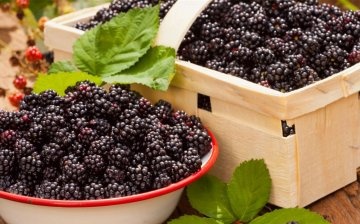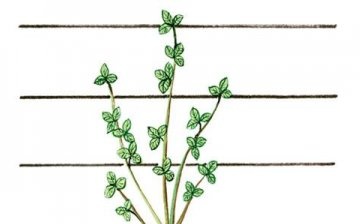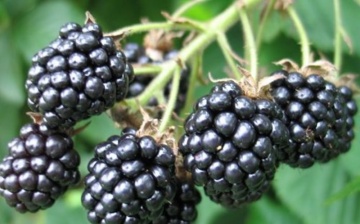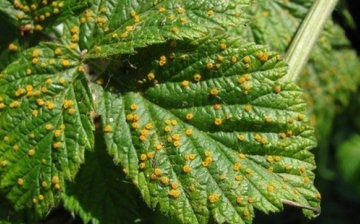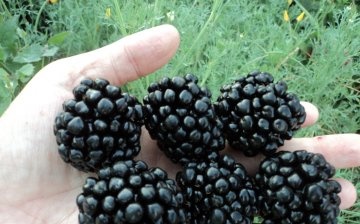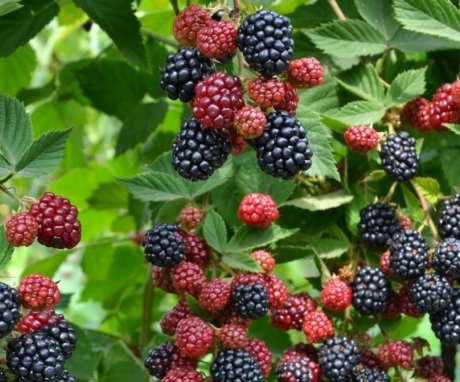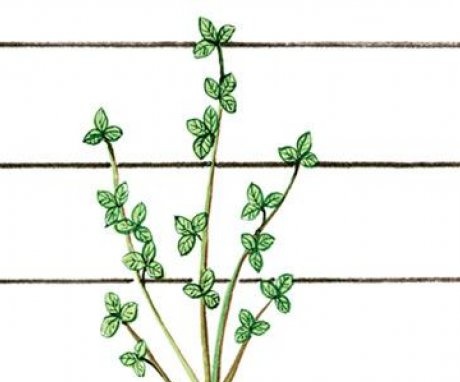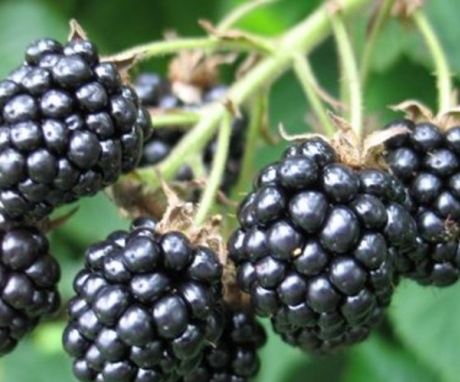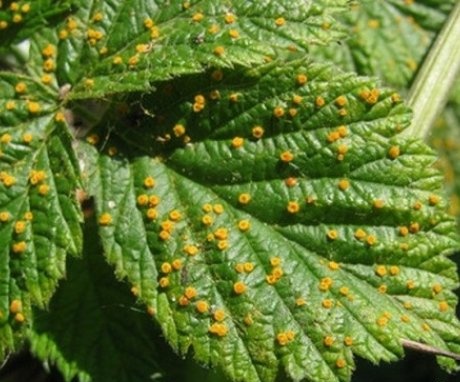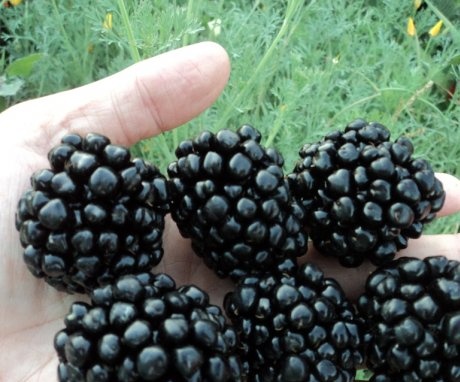Blackberry varieties Leader Joseph: description, planting, care and reviews of the variety
The Blackberry named Chief Joseph is a unique variety of this plant. It was named after the leader of the Indian tribe of North America, as the variety has extraordinary productivity and hardiness. Blackberries adapt perfectly to weather conditions, easily tolerate drought, heat and bear fruit with large black berries.
Content:
- Description and advantages of the variety
- Reproduction and planting
- How to care for blackberries
- Disease and pest control
- Reviews of the Blackberry Chief Joseph
Description and benefits of the variety
The main advantage of the Blackberry variety Chief Joseph is that the bush consists of semi-spreading long branches that do not have thorns. Its unusually large black glossy berries ripen in late summer: mid-July - early August. The bush pleases with its high yield for almost two months. The berries reach an impressive weight: up to 25 g and have a high density, which ensures their good transportability.
As for the taste, the Blackberry Leader Joseph is a very aromatic and sweet berry with a delicate sourness.
The first signal berries have an ordinary, even slightly bland taste, but they still have a sufficient sugar content. Blackberries Leader Joseph, like representatives of other varieties, will reveal their potential only in the third year.
As for the main characteristics of the variety, it has the following indicators:
- vigorous plant with high vigor
- shoots without thorns, reaching 3 or more meters
- the bush gives many shoots with a small root system, grows rapidly
- leaves blackberry not large, have small teeth along the edge
- the plant blooms with large white flowers
- its fruit clusters are multi-berry, the berries are large: from 10 to 25 g, elongated
With proper care, high yield of blackberries can be achieved only in the third year of plant growth - up to 30-35 kg per bush.
Reproduction and planting
When planting a blackberry of the Leader Joseph variety, it is imperative to take into account the habit of the future bush: the splendor and length of its future branches. It would be correct to plant plants at a distance of 2 meters from each other, and the row spacing should be more than 2.5 meters, and when planting a new growth, these distances should be doubled. If planted more densely, it will be difficult to handle (cut, tie) long branches in the future, and even more difficult to harvest.
It is quite easy to propagate a blackberry, for this it is enough to bend the branch and dig in the upper part of it.
When it takes root, it can be separated from the main bush, and the rooted part can be carefully transferred to the desired place for further development. For planting, a hole deep enough for the complete immersion of the root is prepared, fertilized, watered and the future bush sits down with the required distance from other plantings, that is, conditions are created for the full development of green mass.
We must not forget about watering, it should not be abundant, but the soil should not dry out. The root and greenery need moisture, but only if the weather itself does not take care of the plantings and does not indulge in rain.
How to care for blackberries?
Blackberries do not require much maintenance.After planting the seedlings, you need to determine in which direction the bush will develop. It is formed and strengthened with supports and wire. You can collect the branches in bunches and tie them to pegs, or you can bend the shoots and pin them to the ground, so they will creep. There are many ways, but you need to choose the most gentle, since the Vine of the Leader does not have much flexibility. If you treat it carelessly, it can break down.
Care Tips:
- If necessary, the plants are fertilized. It is correct to do this in the first months of spring and preferably before bud swelling and flowering. For this purpose, a nitrogen-mineral complex is used for this culture. When planting a seedling, humus is introduced and the soil is mulched with peat.
- Like any plantings, blackberries need watering, especially on especially hot days. Watering not only prevents the root system from drying out, but also protects the entire bush from overheating.
- The first year it makes no sense to prune the bushes, since the main goal at this time is to build up green mass. Only in the spring, you need to remove frozen, unhealthy and broken branches. In the future, pruning will be needed, because oversaturation of the bush with replacement shoots will only reduce the quality of the crop. From 7 to 10 desired branches are saved, the rest can be cut off.
- During preparation for wintering, the blackberries do not need to be cut, as this reduces the yield. You can only remove very thin branches, they have the highest probability of freezing. For wintering, after stopping fruiting, the vine is removed from the support, bent down and covered with several layers of thick paper or special agrofibre. Some gardeners cover the folded vine with wooden or cardboard boxes, after sprinkling it with foliage.
Disease and pest control
All green spaces have the ability to contract diseases and suffer from all kinds of insects and rodents. Blackberry variety Chief Joseph is resistant to many diseases and damage to his vine by external pests. It adapts well to different climatic conditions and, when properly grown, practically does not get sick.
The main danger for blackberries is rust, leaves are affected by it (they turn yellow and fall off) and young shoots (dry up).
The disease occurs with insufficient watering in dry summers, while the weakest plants die. At the first signs of the disease, it is enough to spray the bush with an infusion of garlic, for this 300 g of its crushed gruel must be diluted in 3 liters of water and insisted for a day. The finished infusion must be filtered and diluted in 10 liters of warm water, only then can the bush be sprayed. Spraying will get rid not only of rust, but also of mites and aphids.
You can fight the disease with a sulfur preparation: 100 g of sulfur per 10 liters of water. It is very effective against almost all types of fungi. It is possible to spray with a suspension only in warm weather up to + 18 degrees. An old proven remedy will protect blackberries from most diseases - a 0.5% solution of soda ash with laundry soap (50 g of soda, 50 g of soap and 10 liters of water).
The control of weeds and thickets will help to save the bushes from the spread of diseases, this will provide them with good ventilation. In autumn and spring, manure or NPK fertilizers should be applied. It should be remembered that not only drought, but also excessive watering can also harm the plantation.
Reviews of the Blackberry Chief Joseph
Many amateur gardeners, in particular berry lovers blackberry and raspberries, are trying to acquire on their site the new most fruitful types of crops. Having planted, grown and harvested blackberries, they share their experience and impressions of the result with the rest of the gardeners. Chief Joseph has mixed reviews. Some say that the berry is sour, judging it by the first harvest, others call it tasteless, and still others are very pleased with the large harvest of large sweet and aromatic berries.
Probably not everyone understands that the yield and taste of a berry directly depend on climatic conditions (in a rainy summer it will be sour) and on top dressing (in lifeless soil, the berries will be small and fresh). One of the main disadvantages in growing vines, gardeners call it fragility, but with careful handling it is not a problem at all.
Having good planting material, planting a bush in a place comfortable for a plant in a good fertilized soil and adhering to all the rules of care, you can achieve a bountiful harvest from this variety with absolutely amazing taste.
Plant high-yielding blackberries, grow and enjoy the exquisite flavor of their aromatic berries.
After all, they are not only tasty, but also useful: they have a huge range of nutrients and medicinal substances, such as glucose, fructose, sucrose, as well as a significant vitamin complex of groups A, C, E, B, P, PP, K and minerals: potassium, manganese and copper. And this is not the whole list of the variety's advantages. Leader Joseph Berries is a true natural healer that you will always have at your fingertips.
More information can be found in the video:



